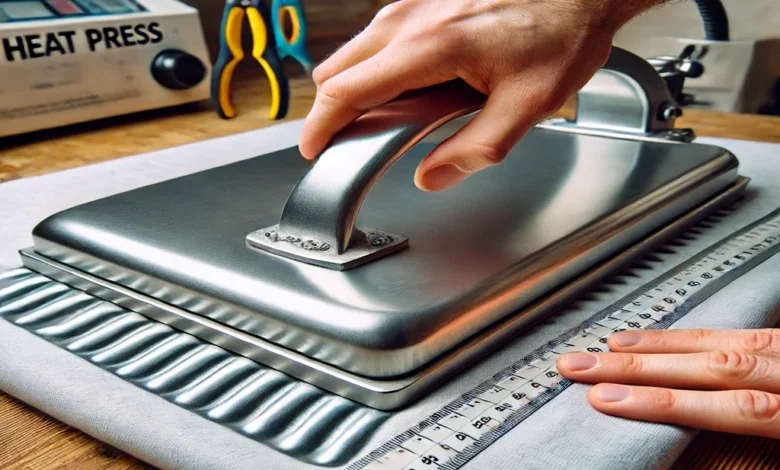
A heat press is a crucial tool in various industries, especially for printing and manufacturing. It applies heat and pressure to materials, enabling processes such as heat transfer printing and lamination. The heart of a heat press is its heat platen—a flat, heated surface that ensures even heat distribution.
However, if you notice a raised bump on your heat platen, it can significantly affect the quality of your prints and transfers. Uneven heat and pressure can lead to defective products, wasted materials, and costly repairs. In this article, we will explore the common causes, effects, solutions, and preventive measures to help you maintain an optimal heat platen.
What is a Heat Platen?
A heat platen is the heated metal plate in a heat press machine. It is typically made from aluminum because of its excellent heat conductivity and lightweight properties. The platen’s primary role is to maintain a uniform temperature across its surface to ensure consistent heat transfer to the material being pressed.
For best performance, the heat platen must remain perfectly flat. Even a small bump or uneven area can cause issues during the heat transfer process, resulting in imperfect prints, incomplete designs, or damage to the substrate.
What Causes a Raised Bump on a Heat Platen?
A raised bump on your heat platen can develop due to various reasons, including physical damage, thermal expansion, residue build-up, and manufacturing defects. Let’s explore these causes in detail:
1. Residue and Build-Up
Over time, adhesives, inks, fabric particles, or melted vinyl can accumulate on the platen’s surface. When these materials harden, they create raised spots that interfere with heat transfer. This is common when:
- Using heat transfer vinyl (HTV) without a protective cover sheet.
- Printing with sublimation paper that leaves ink residues.
- Not cleaning the platen regularly after each use.
2. Thermal Expansion and Contraction
Heat platens undergo repeated heating and cooling cycles. Poor-quality platens or excessive temperature fluctuations can cause the metal to expand and contract unevenly, leading to warping or the formation of raised areas.
3. Physical Damage
If the heat press is dropped, mishandled, or impacted by heavy objects, it may dent, warp, or develop raised bumps. Even minor scratches can eventually become problematic, affecting the platen’s smoothness.
4. Manufacturing Defects
Sometimes, a platen may come with defects from the factory. If the platen was not machined or assembled correctly, small imperfections may become noticeable after repeated use.
5. Improper Maintenance
Failure to clean and inspect the platen regularly can lead to long-term damage. Dirt, debris, and hardened residues left untreated can create bumps over time, affecting performance.
Also Read: Can A 5800h Do Ps4 Emulation And 3060 Mobile
Effects of a Raised Bump on a Heat Platen
A raised bump may seem like a minor issue, but it can cause several problems, including:
1. Uneven Heat Distribution
Since heat platens must stay flat to apply consistent heat, a raised bump prevents even heat transfer, leading to:
- Cold spots where the heat does not reach properly.
- Overheated areas that may burn materials.
- Inconsistent prints with faded or incomplete designs.
2. Imbalanced Pressure
Heat presses rely on even pressure to transfer designs successfully. A raised bump disrupts the balance, causing some areas to receive too much pressure while others receive too little. This results in:
- Misaligned or distorted prints.
- Fabric damage or creases.
- Peeling or lifting of vinyl transfers.
3. Material Damage
Excessive pressure on one part of the material due to a raised bump can cause:
- Scorching or burning of fabric.
- Warping of heat-sensitive materials.
- Permanent creases in prints or designs.
4. Wasted Materials and Time
A single bump can ruin multiple prints, leading to wasted vinyl, fabric, transfer paper, and ink. This increases production costs and reduces efficiency, especially for businesses that rely on high-quality prints.
How to Fix a Raised Bump on a Heat Platen
If you notice a bump on your heat platen, take these steps to resolve it:
1. Turn Off and Cool Down the Heat Press
Before inspecting or repairing the platen, turn off the machine and let it cool completely to avoid burns or damage.
2. Clean the Surface
- Use a non-abrasive cleaner and a soft cloth to remove any residue.
- If the bump is caused by hardened ink or adhesive, apply rubbing alcohol or a heat platen cleaner.
- Do not use sharp objects to scrape off debris, as this can damage the platen.
3. Check for Physical Damage
- Place a straightedge (like a ruler) across the platen to check for warping or bumps.
- If the bump is a minor dent, gently sand it using fine-grit sandpaper.
- If the bump is severe, consider resurfacing or replacing the platen.
4. Recalibrate the Machine
- Ensure that the heat press is properly aligned and calibrated.
- Adjust the pressure settings if they seem uneven.
5. Contact the Manufacturer
- If the issue is due to a manufacturing defect, check if your heat press is under warranty and contact the manufacturer for a replacement.
How to Prevent Bumps on a Heat Platen
To maintain a smooth and effective heat platen, follow these preventive measures:
1. Clean After Each Use
- Wipe down the platen with a damp cloth or heat press cleaner.
- Remove any adhesive, ink, or fabric particles immediately before they harden.
2. Use Protective Sheets
- Place a Teflon sheet or silicone pad over the platen when pressing materials.
- This prevents residue build-up and protects the platen’s surface.
3. Avoid Excessive Pressure
- Use manufacturer-recommended settings to avoid unnecessary stress on the platen.
- Overloading with thick materials can lead to bending or warping over time.
4. Store the Heat Press Properly
- When not in use, cover the platen to protect it from dust and debris.
- Store the heat press in a temperature-controlled environment to prevent expansion and contraction damage.
5. Regular Inspections
- Check for minor scratches or dents and fix them before they become bigger issues.
- If you notice uneven heating, test the temperature using a heat gun or infrared thermometer.
Conclusion
A raised bump on your heat platen can significantly impact the quality of your prints, leading to uneven heat transfer, pressure imbalances, and material damage. Understanding the causes—such as residue build-up, thermal expansion, physical damage, and manufacturing defects—can help you prevent and fix these issues effectively.
Also Read: Shilpa Max Florida Wedding: A Multicultural Celebration of Love
By following regular maintenance practices, cleaning your platen, using protective sheets, and inspecting for damage, you can extend the life of your heat press and ensure high-quality printing results. If the problem persists, consider resurfacing or replacing the platen to maintain efficiency and product quality.
By taking these steps, you can keep your heat press in optimal condition and avoid costly production mistakes.


